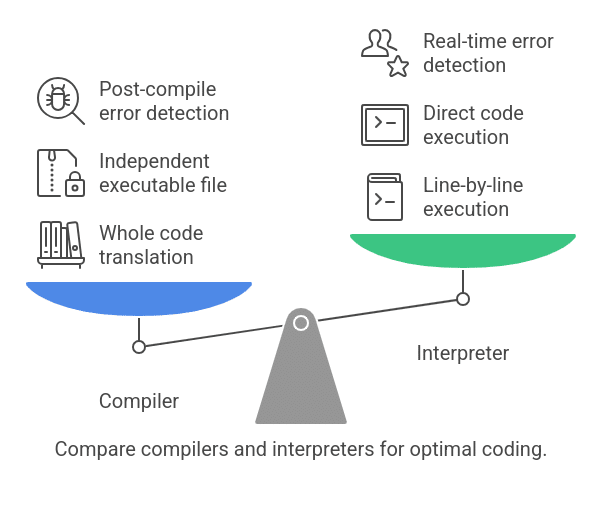In the realm of programming, compilers and interpreters are two fundamental tools that serve to convert high-level programming languages into machine-readable instructions.
While both have the same primary goal, they function in very different ways. Therefore, understanding the difference is essential for developers, as it affects program execution, performance, and development workflow.
In this article, we’ll explore each tool and compare them directly to highlight their key distinctions.
What is a Compiler?
A compiler is a program that translates the entire source code of a high-level programming language into machine code or intermediate code in one go. This process results in a standalone executable file that can be run independently, without the need for the compiler to be present.

The compilation process consists of several stages:
- Lexical Analysis: The source code is broken down into tokens (the smallest units of meaningful data, such as keywords, operators, and identifiers).
- Syntax Analysis: The tokens are analyzed according to the grammar rules of the programming language to create a parse tree.
- Semantic Analysis: The compiler ensures that the program has a logical structure, i.e., there are no type mismatches or other logical errors.
- Code Optimization: The generated code is optimized to make the program more efficient in terms of performance and memory usage.
- Code Generation: Finally, machine code (or intermediate code) is generated, which is then packaged into an executable file.
Advantages of Compilers:
- Faster Execution: Once the code is compiled, the resulting executable can be run without the need for the compiler, which makes it faster during execution.
- Efficient Memory Usage: Since the program is already compiled, it uses less memory during runtime.
Examples of Compiler-Based Languages:
What is an Interpreter?
An interpreter is a program that reads high-level source code and translates it into machine code line-by-line, executing it as it goes. Unlike a compiler, an interpreter does not generate an independent executable file. Instead, the interpreter is required to run the program every time.

The interpretation process is relatively straightforward:
- Read Line-by-Line: The interpreter reads one line of code at a time.
- Translate and Execute: It immediately translates that line into machine code and executes it.
- Error Handling: If an error occurs, the interpreter halts execution at the problematic line and alerts the programmer to the issue.
Advantages of Interpreters:
- Real-Time Execution: Because interpreters process the code line-by-line, developers can see the results immediately, which is ideal for debugging and development.
- Portability: The source code can be run on any system with the appropriate interpreter without needing a specific compiled executable.
Examples of Interpreter-Based Languages:
- Python, JavaScript, Ruby, PHP
Compiler vs Interpreter: A Detailed Comparison
Now that we’ve covered the fundamentals of both compilers and interpreters let’s compare them across several critical factors:
| Feature | Compiler | Interpreter |
| Translation Process | Translates the entire source code at once. | Translates and executes code line-by-line. |
| Output | Produces an independent executable file. | Executes the code directly, no separate file. |
| Error Detection | Identifies errors after the whole code is compiled. | Identifies errors line-by-line during execution. |
| Speed of Execution | Faster execution after compilation. | Slower execution due to real-time translation. |
| Memory Usage | Uses less memory during execution. | Uses more memory during execution. |
| Examples of Languages | C, C++, Java | Python, JavaScript, Ruby |

Key Differences:
1. Translation Process:
- Compiler: A compiler processes the entire source code before generating the output. This means that the code is converted to machine code in one go, and only the final executable is produced.
- Interpreter: An interpreter processes the code line-by-line, converting each line into machine code as the program is executed.
2. Execution Speed:
- Compiler: Once the program is compiled, execution is very fast because the code is already translated into machine code. You only need to compile the code once.
- Interpreter: The execution is slower because the interpreter must translate each line in real-time during execution.
3. Memory Usage:
- Compiler: Compiled programs are more memory-efficient because the translation is done ahead of time, and no further processing is required during execution.
- Interpreter: Interpreted programs consume more memory since the interpreter must be loaded into memory each time the program runs and processes the code line-by-line.
4. Error Detection:
- Compiler: Errors are detected only after the entire code is analyzed. This means that the compilation process will stop if there are any errors, and you must fix all issues before proceeding.
- Interpreter: Errors are detected one at a time as the interpreter processes each line of code. As soon as an error is found, the interpreter halts, and the programmer can correct the issue.
5. Output Generation:
- Compiler: A compiler produces a standalone executable file after the compilation process, which can be executed without the compiler.
- Interpreter: An interpreter does not produce an output file but directly executes the code line-by-line.
Practical Applications of Compiler and Interpreter
Both compilers and interpreters serve specific purposes depending on the type of programming language and the application at hand.
- Compilers are often used for system software, applications requiring high performance (e.g., gaming engines, large-scale enterprise software), and languages like C, C++, and Java.
- Interpreters are preferred for scripting, rapid prototyping, web development, and languages that require flexibility and immediate execution, such as Python, JavaScript, and Ruby.
Conclusion
In conclusion, the difference between compiler and interpreter is defined by how the source code is translated into machine-readable instructions.
While a compiler translates the entire program at once into machine code, resulting in faster execution and independent output files, an interpreter translates and executes code line-by-line, making it more flexible and helpful for development but at the cost of slower execution speed.
If you’re looking to deepen your programming skills and learn more about various programming languages and tools, consider enrolling in our free software engineering courses. With lifetime access, comprehensive lessons, and the opportunity to earn certificates, our courses will help you advance in the world of software development.
Frequently Asked Questions
1. Can a programming language use both a compiler and an interpreter?
Yes, some languages like Java use both. The compiler converts code to bytecode, and the interpreter (JVM) executes it. This balances performance and flexibility.
2. Why are interpreted languages preferred for web development?
Interpreted languages like JavaScript enable real-time execution. They allow quick testing, debugging, and updates, making them ideal for web applications.
3. Do compilers always generate machine code?
Not always; some compilers generate intermediate code. For example, Java compiles to bytecode, which runs on the JVM instead of direct machine code.
Related: Why is Java Platform Independent?
4. Can interpreted code be converted into compiled code?
Yes, through Just-In-Time (JIT) compilation. JIT compiles code during runtime for better performance, used in Java, Python (PyPy), and JavaScript (V8).
5. Which is more secure: compiled or interpreted code?
Compiled code is generally more secure as it hides source code. Interpreted code exposes scripts, making it easier to reverse-engineer or modify.






